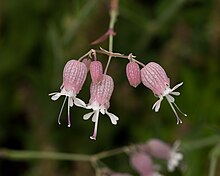Silene vulgaris
| Silene vulgaris | |
|---|---|

| |
| Scientific classification | |
| Kingdom: | Plantae |
| Clade: | Tracheophytes |
| Clade: | Angiosperms |
| Clade: | Eudicots |
| Order: | Caryophyllales |
| Family: | Caryophyllaceae |
| Genus: | Silene |
| Species: | S. vulgaris
|
| Binomial name | |
| Silene vulgaris (Moench) Garcke
| |
| Synonyms | |
|
Oberna behen (L.) Ikonn. | |

Silene vulgaris, the bladder campion[3] or maidenstears,[4] is a plant species of the genus Silene of the family Caryophyllaceae. It is native to Europe, where in some parts it is eaten, but is also widespread in North America, where it is a common wildflower in meadows, open woods, and fields.[5]
Gastronomy[]

The young shoots and the leaves may be used as food in some countries of the Mediterranean region.[6] The tender leaves may be eaten raw in salads. The older leaves are usually eaten boiled or fried, sauteed with garlic as well as in omelettes.
Crete and Cyprus[]
In Crete it is called agriopapoula (αγριοπάπουλα) and the locals eat its leaves and tender shoots browned in olive oil.[7]
In Cyprus it is very widely eaten, so much that it has, in recent years, come back into being cultivated and sold in shops in bunches. Two of the common Cypriot names are strouthouthkia (στρουθούθκια; [stru'θuθca]) and tsakrithkia (τσακρίδκια; [t͡sa'kriðca]).[8]
Italy[]
In Italy the leaves of this plant may be used also as an ingredient in risotto. It is commonly known as sculpit, stridolo, or by the obsolete scientific name Silene inflata, as well as s-ciopetin, or grixol in Veneto, and nenkuz, or sclopit in Friuli and cojet in Piedmont.
Spain (La Mancha)[]
Formerly in La Mancha region of Spain, where Silene vulgaris leaves are valued as a green vegetable, there were people known as "collejeros" who picked these plants and sold them. Leaves are small and narrow, so it takes many plants to obtain a sizeable amount.
In La Mancha the Silene vulgaris leaves, locally known as "collejas", were mainly used to prepare a dish called gazpacho viudo (widower gazpacho). The ingredients were flatbread known as tortas de gazpacho and a stew prepared with Silene vulgaris leaves.[9] Other dishes prepared with these leaves in Spain include "potaje de garbanzos y collejas", "huevos revueltos con collejas" and "arroz con collejas".
See also[]
- List of plants with edible leaves
- Castilian-Manchego cuisine
References[]
- ^ Royal Botanic Gardens, Kew
- ^ Sprague, T.A.; Green, M.L. (1933). "Silene Cucubalus: The Correct Name of the Bladder-Campion". Bulletin of Miscellaneous Information (Royal Botanic Gardens, Kew). Royal Botanic Gardens, Kew. 1933 (3): 151. doi:10.2307/4113530. JSTOR 4113530.
- ^ Bladder Campion, Prov. of Ontario
- ^ USDA, NRCS (n.d.). "Silene vulgaris". The PLANTS Database (plants.usda.gov). Greensboro, North Carolina: National Plant Data Team. Retrieved 15 November 2015.
- ^ Bladder Campion, Prov. of Ontario
- ^ Fernald, Merritt Lyndon; Alfred Charles Kinsey; Reed C. Rollins (1996). "Bladder-Campion, Maiden's Tears, Snappery, Silene Cububalis (or latifolia)". Edible Wild Plants of Eastern North America. New York City: Dover Publications. pp. 193–194. ISBN 0-486-29104-9. OCLC 33666218. Retrieved 23 February 2009.
- ^ Kleonikos G. Stavridakis , Κλεόνικος Γ. Σταυριδάκης (2006). Wild edible plants of Crete - Η Άγρια βρώσιμη χλωρίδα της Κρήτης. Rethymnon Crete. ISBN 960-631-179-1.
- ^ Christou, Eleni. "Στρουθούθκια". Εικονικό Μουσείο Κυπριακών Τροφίμων και Διατροφής (Cyprus Food Virtual Museum). Πανεπιστήμιο Κύπρου (University of Cyprus). Retrieved 2022-02-05.
- ^ Gazpacho viudo recipe
External links[]
- Silene
- Flora of Europe
- Flora of temperate Asia
- Flora of North Africa
- Flora of Macaronesia
- Saponaceous plants